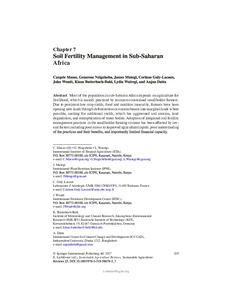| dc.contributor.author | Masso, C. |
| dc.contributor.author | Nziguheba, Generose |
| dc.contributor.author | Mutegi, J. |
| dc.contributor.author | Galy-Lacaux, C. |
| dc.contributor.author | Wendt, J. |
| dc.contributor.author | Butterbach-Bahl, Klaus |
| dc.contributor.author | Wairegi, L. |
| dc.contributor.author | Datta, A. |
| dc.date.accessioned | 2019-12-04T11:11:30Z |
| dc.date.available | 2019-12-04T11:11:30Z |
| dc.date.issued | 2017 |
| dc.identifier.citation | Masso, C., Nziguheba, G., Mutegi, J., Galy-Lacaux, C., Wendt, J., Butterbach-Bahl, K., ... & Datta, A. (2017). Soil fertility management in sub-Saharan Africa. In E. Lichtfouse, Sustainable agriculture reviews (p. 205-231). Cham: Springer. |
| dc.identifier.issn | 2210-4410 |
| dc.identifier.uri | https://hdl.handle.net/20.500.12478/2443 |
| dc.description | Published online: 04 May 2017 |
| dc.description.abstract | Most of the population in sub-Saharan Africa depends on agriculture for livelihood, which is mainly practiced by resource-constrained smallholder farmers. Due to persistent low crop yields, food and nutrition insecurity, farmers have been opening new lands through deforestation or encroachment into marginal lands where possible, seeking for additional yields, which has aggravated soil erosion, land degradation, and eutrophication of water bodies. Adoption of integrated soil fertility management practices in the smallholder farming systems has been affected by several factors including poor access to improved agricultural inputs, poor understanding of the practices and their benefits, and importantly limited financial capacity.
Here we review challenges of soil fertility management in the smallholder farming systems of sub-Saharan Africa. Our major findings are: (1) most countries have not been able to meet the fertilizer target of 50 kg nutrients ha−1 by 2015 in the 2006 Abuja Declaration; over 65% of the smallholder farmers have not used fertilizer and 75% of the agricultural soils have been affected by nutrient depletion. (2) Poor agricultural practices have resulted in an average annual nutrient loss of 50 kg ha−1, which represented an equivalent of US$ four billion lost in 2008 and an estimated economic cost of up to 18% of the gross domestic product in addition to eutrophication of water bodies. (3) Value cost ratios of agricultural inputs that are less than three are common, which has limited the profitability of integrated soil fertility management practices.
(4) Proliferation of fake agricultural inputs has been reported in over 40–60% of the cases as a consequence of poor enforcement of quality standards. (5) In addition to blanket recommendations, fertilization has focused on nitrogen, phosphorus and potassium, with little emphasis on secondary and micro-nutrients as well as organic amendments or liming materials in acid soils, which has generally resulted in poor crop responses or low yield increments. (6) Effective adoption of integrated soil fertility management would result in at least doubling the current nutrient agronomic use efficiency in the smallholder farming systems and reduction of the actual yield gap averaged to more than 300% for cereal and legume crops. Based on these findings, operationalization of supportive policies to increase adoption of good agronomic practices and investment in research to develop solutions appropriate to smallholder farmers should be recommended. |
| dc.description.sponsorship | Bill & Melinda Gates Foundation |
| dc.format.extent | 205-231 |
| dc.language.iso | en |
| dc.publisher | Springer |
| dc.relation.ispartofseries | Sustainable Agriculture Reviews;25 |
| dc.subject | Nutrient |
| dc.subject | Policies |
| dc.subject | Smallholders |
| dc.subject | Farming Systems |
| dc.subject | Soil Fertility |
| dc.subject | Management |
| dc.subject | Soil Fertility Management |
| dc.subject | Sub-Saharan Africa |
| dc.title | Soil fertility management in sub-Saharan Africa |
| dc.type | Book Chapter |
| dc.description.version | Peer Review |
| cg.contributor.crp | Grain Legumes |
| cg.contributor.crp | Water, Land and Ecosystems |
| cg.contributor.affiliation | International Institute of Tropical Agriculture |
| cg.contributor.affiliation | International Plant Nutrition Institute |
| cg.contributor.affiliation | Laboratoire d'Aérologie, France |
| cg.contributor.affiliation | International Fertilizer Development Center |
| cg.contributor.affiliation | Karlsruhe Institute of Technology |
| cg.coverage.region | Africa |
| cg.coverage.region | West Africa |
| cg.coverage.country | Nigeria |
| cg.authorship.types | CGIAR and developing country institute |
| cg.iitasubject | Integrated Soil Fertility Management |
| cg.iitasubject | Smallholder Farmers |
| cg.iitasubject | Soil Fertility |
| cg.iitasubject | Soil Health |
| cg.howpublished | Formally Published |
| cg.accessibilitystatus | Limited Access |
| local.dspaceid | 93027 |
| cg.targetaudience | Scientists |
| cg.identifier.doi | 10.1007/978-3-319-58679-3_7 |

